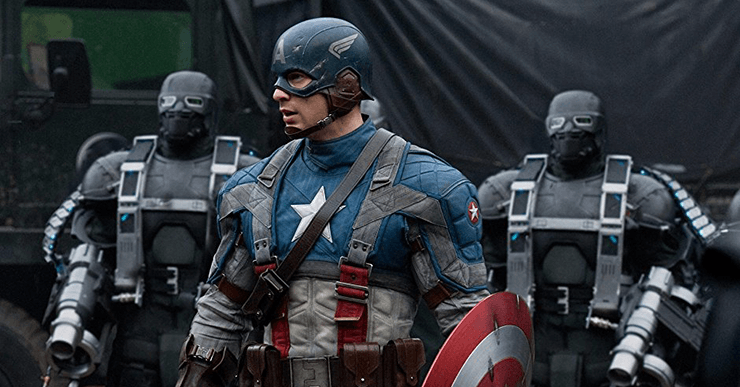In 1940, the United States hadn’t yet entered the war after the War to End All Wars, but two comics creators didn’t like what they were seeing. Two young Jewish men, who were born Hymie Simon and Jacob Kurtzberg, but who changed their names to Joe Simon and Jack Kirby to better assimilate, saw what the Axis powers were doing to Europe in general and to their fellow Jews in particular, and were angry and frightened.
And so, in December 1940, Captain America #1 debuted. Dressed in a costume with a flag motif and carrying a red-white-and-blue shield, the cover of the first issue had Cap punching Adolf Hitler in the face. The character was very polarizing—Simon and Kirby got several death threats interspersed with the avalanche of fan mail, as there were plenty of people in this country who wanted to stay the hell out of the fighting overseas—but ultimately proved hugely popular, especially after the bombing of Pearl Harbor a year later put the U.S. in the war.
After an awful movie serial in 1944, two terrible TV movies in 1979, and a 1990 film that never got (or deserved) a theatrical release, Captain America finally got a proper feature film seventy years after Pearl Harbor.
Captain America was by far Timely Comics’s most popular character, inspiring a fan club (the Sentinels of Liberty) and tons of other merchandise, not to mention that crummy movie serial. After World War II ended, however, his popularity waned, with his title ending in 1949. They revived the character in 1953 and showed him fighting Communist agents, but it only lasted a year.
When Timely—becoming known better as Marvel Comics—started their little superhero revolution in the early 1960s, Kirby and Stan Lee decided to bring Cap back in Avengers #4, establishing that he was in suspended animation in the Arctic since the end of the war. (The 1950s version of Cap and his sidekick Bucky was ignored initially, and then retconned in a 1972 story by Steve Englehart as a pair of knock-offs. That Cap and Bucky went nuts, with Cap dying, and Bucky being cured of his insanity and becoming the hero Nomad.)
Cap quickly became the heart of the Avengers, and also thrived in his own adventures. Initially sharing the Tales of Suspense title with Iron Man, with the hundredth issue in 1968 it was retitled Captain America, with Iron Man getting his own separate title.
Marvel’s attempts to do Cap right on film in the 21st century were stymied initially by a lawsuit brought about by Simon over rights to the character (Marvel and Simon eventually settled), and then by the writers strike of 2007. Eventually, however, the film got greenlit. The original intent was to have half the film take place during World War II and the other half in the present day, but that was quickly abandoned for a straight-up WWII pic. (Perhaps they recalled that that formula didn’t exactly work the last time they tried it.) Joe Johnston—who had directed October Sky and The Rocketeer, both period pieces—was hired to direct, and he brought in Christopher Markus and Stephen McFeely to write the script. Markus and McFeely have since become two of the go-to writers of the Marvel Cinematic Universe—they would go on to write the subsequent two Cap films, the two Avengers: Infinity War movies, and Thor: Dark World.
Buy the Book
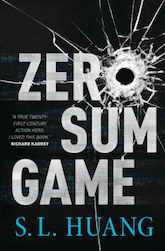

Zero Sum Game
Chris Evans was cast in the title role, for which Ryan Philippe, John Krasinski, and Sebastian Stan were also considered. Stan wound up being cast as Bucky, with Hayley Atwell as Peggy Carter, Tommy Lee Jones as Colonel Phillips (a minor character in one of the 1960s expanded retellings of Cap’s origin), Stanley Tucci as Dr. Erskine, Hugo Weaving as the Red Skull, and Toby Jones as the Skull’s right hand Arnim Zola (in the comics, Zola is a geneticist who experimented on his own body, giving him a face on a TV screen in his chest—there’s a visual reference to that in the movie). Returning are the characters of Howard Stark from Iron Man 2, played as a younger man by Dominic Cooper, and Samuel L. Jackson from Thor as Nick Fury. Neal McDonough, Derek Luke, Kenneth Choi, Bruno Ricci, and JJ Feild play the Howling Commandos, though they’re never referred to as such.
Originally, the Howling Commandos were a diverse group of soldiers under the leadership of Sergeant Nick Fury, who would go on twenty years after the war to become the head of S.H.I.E.L.D., with several of his commandos working for him at the spy agency as well. The Fury connection is dropped for the movie, with the team led by McDonough’s “Dum Dum” Dugan, complete with trademark mustache and bowler hat from the comics.
Bucky’s backstory was changed from the comics as well, using elements of the “Ultimate” line’s version of Bucky, and also combining the mainline Bucky with that of Arnold Roth, who was established as Rogers’s childhood friend who protected him from bullies, as Bucky does here.
And the Red Skull was altered—while he keeps the comics’ version’s real name of Johann Schmidt, he is no longer a lower-class citizen raised to prominence by Adolf Hitler with no special powers. Instead, he’s a scientist who leads Hydra (thus combining the Skull with Baron Wolfgang von Strucker, who ran Hydra during the war in the comics), and he also is given the Super Soldier Serum that is later given to Rogers, though it has the side effect of turning his skin red and his face into a skull shape. (In the comics, the Red Skull is a normal-looking person wearing a mask.)
Also, for reasons passing understanding, Rogers’s home neighborhood was changed from the Lower East Side—the section of Manhattan where Jack Kirby was born and raised—to Brooklyn for no compellingly good reason. Since the character’s co-creator was from the Lower East Side, to move his home to Brooklyn seems pointless and arbitrary, and an insult to “King” Kirby, especially since the popularity of this version of the character has led to a Cap statue being placed in Brooklyn, because that’s supposedly his home—but it isn’t. In the canonical source material of the character, he’s from the Lower East Side, dagnabbit. It’s also hugely disappointing that seminal Cap writers Roger Stern (who established a lot of Rogers’s pre-Cap background), J.M. DeMatteis (who gave the Skull the Johann Schmidt name, and generally wrote the quintessential Cap-Skull confrontation), and Fabian Nicieza (from whose The Adventures of Captain America miniseries this movie takes a great deal) didn’t get a “special thanks to” credit at the end along with various other Cap scribes.
Evans and Jackson will next appear in Avengers. Atwell, Stan, and Jones will next appear in Captain America: The Winter Soldier. Cooper and McDonough will next appear in the Agent Carter one-shot as well as the Marvel’s Agent Carter TV series that spun off from the one-shot. The Red Skull will reappear, played by Ross Marquand, in Avengers: Infinity War.
Simon’s grandchildren attended the premiere of this movie in July 2011, and called their grandfather at home when he was announced as the creator. Simon died later that year at the age of 98.
“I knocked out Adolf Hitler over two hundred times”
Captain America
Written by Christopher Markus & Stephen McFeely
Directed by Joe Johnston
Produced by Kevin Feige
Original release date: July 19, 2011
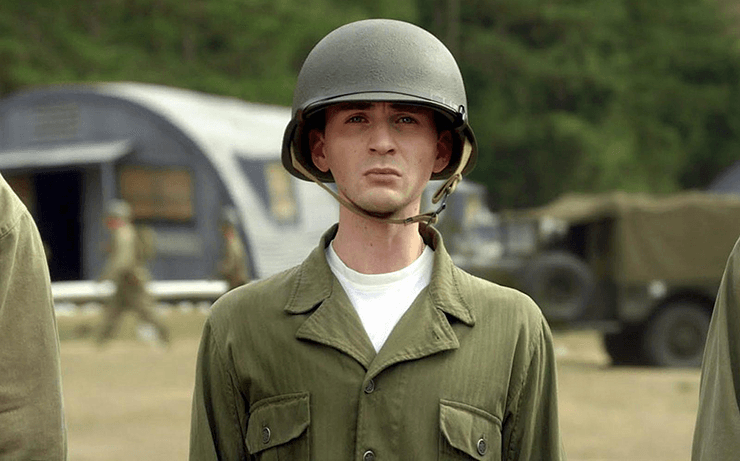
In the Arctic, two agents of S.H.I.E.L.D. are summoned to the site of a large vessel that has been uncovered by the changing landscape of the ice floes. They drill their way into the massive metal conveyance and find a person holding a red-white-and-blue shield frozen in ice.
Flash back to 1942. In Norway, Johann Schmidt, the head of Hydra—the deep-science arm of the Nazi Party—invades a small town where an old man is guarding the Tesseract. An object of great power that once was part of Odin’s trophy room, it has been hidden on Earth for generations behind a relief sculpture on a wall of Yggdrasil, the World Tree of Norse myth (and which Thor explained to Jane Foster one movie ago is a symbol for the links between worlds that are linked by the Bifrost). Schmidt takes it back to one of Hydra’s redoubts in Europe, where his chief scientist, Dr. Arnim Zola, is able to harness the Tesseract’s energy into weapons.
In Brooklyn, Steve Rogers is a short, skinny young man who keeps trying to enlist in the Army, but is rated 4F. He’s tried at several different recruitment centers, giving a different home town each time, and routinely rejected. He also is regularly bullied, refusing to back down but allowing himself to get beat up repeatedly and just getting back up. On the most recent occasion, he’s saved by James Buchanan “Bucky” Barnes, his best friend. Barnes has successfully enlisted, and is going to join the 107th as a sergeant. The night before he ships out, they go to a World’s Fair-type exhibition, where young Howard Stark demonstrates a prototype for a flying car (which doesn’t quite work). Rogers tries to enlist again, and this time his eagerness is noticed by Dr. Abraham Erskine.
Erskine is a German scientist who came to the U.S. after being drafted by Hydra to create a super soldier. His formula was used on Schmidt, and Erskine has brought it to America, working with the Strategic Scientific Reserve on Operation: Rebirth. The SSR, under Erskine, U.S. Army Colonel Chester Phillips, and MI-6 Agent Peggy Carter, are trying to create super-soldiers for the Allies. The other candidates to be the guinea pig are all able-bodied soldiers. Phillips is less sanguine about Rogers, and really only allowed him as a favor to Erskine. However, Rogers proves his intelligence and courage in due course. The former when he’s the first person in seventeen years to successfully bring down a flag from a pole. (Everyone else tries and fails to climb the pole. Rogers removes the pin and screw holding the pole up so it falls to the ground, and then he easily removes the flag.) The latter when Phillips throws a grenade into the midst of the soldiers, and everyone runs—except Rogers, who jumps on top of it, urging everyone else to get to safety.
Finally, Rogers is taken to a secret base in Brooklyn. Erskine has explained that he chose Rogers because the formula amplifies what’s already there. It made Schmidt from a bad person into an evil person, and he’s convinced it will take Rogers’s innate goodness and expand it.
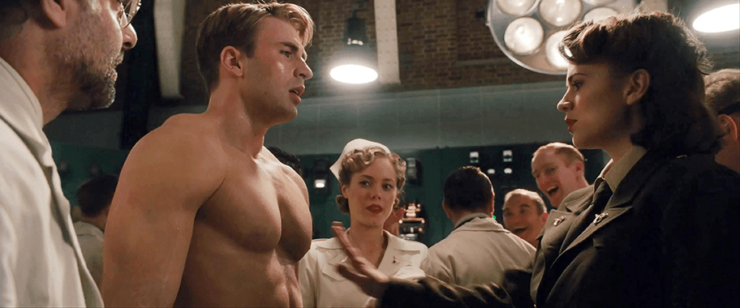
The experiment is a success, using Erskine’s formula and hardware provided by Stark. Rogers is now bigger and more muscular. (When Carter asks how he feels, he says, “Taller.”) Unfortunately, the representative from the State Department, who accompanied Senator Brandt, turns out to be a mole from Hydra. He shoots Erskine and dozens of other agents, steals the formula, and flees the scene. Rogers and Carter give chase. Carter takes out the assassin’s driver with a brilliant shot, but the assassin steals a cab and drives away. Rogers pursues on foot, eventually arriving at the Brooklyn Navy Yards, where the bad guy has a mini-submarine waiting for him. Rogers swims after him, ripping the cockpit open and bringing the saboteur to the surface. But he has a cyanide pill in a hollow tooth, which he swallows before he can be captured. His last words are, “Hail Hydra.”
Stark has never seen technology like the submarine. The SSR is going to the front lines to take the fight to Schmidt. Rogers isn’t going with them, however, as Phillips wanted an army and all he got was one soldier. He wants to send him to Alamogordo, but Brandt has another idea.
Rogers is put in a flag-themed costume, given a flag-themed shield, and he goes on a USO tour around the states, encouraging people to buy war bonds in the guise of “Captain America,” ending each show by socking an actor playing Hitler in the jaw. There are also propaganda movies starring Cap, comic books, and more.
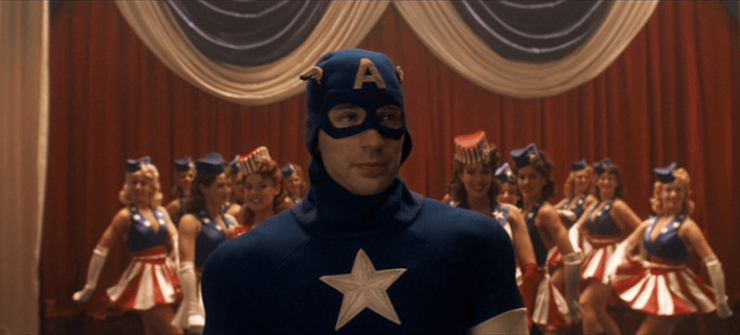
While the shows are a hit in the U.S., when Brandt sends him overseas, he’s less well received. The soldiers don’t want to hear from a guy in tights, they just want to see the dancing girls. Carter visits him between shows, and tells him that the soldiers he’s talking to are all that’s left of the 107th, which took on Hydra and got creamed. Rogers goes to a pissed-off Phillips asking if Barnes is one of the casualties. Phillips has no plans to mount a rescue of anyone Hydra has imprisoned, as they would lose more people than they’d save with an assault—and, Phillips adds, Rogers would know that if he wasn’t a chorus girl.
Encouraged by Carter, who like Erskine and Rogers himself believes that Rogers is meant for better things than being, well, a chorus girl, Rogers decides to mount a one-person rescue. Stark flies him behind enemy lines in his private plane, and Rogers manages to infiltrate the Hydra base, free a bunch of soldiers (including Sergeant Timothy “Dum Dum” Dugan), and grab a piece of technology that uses the Tesseract.
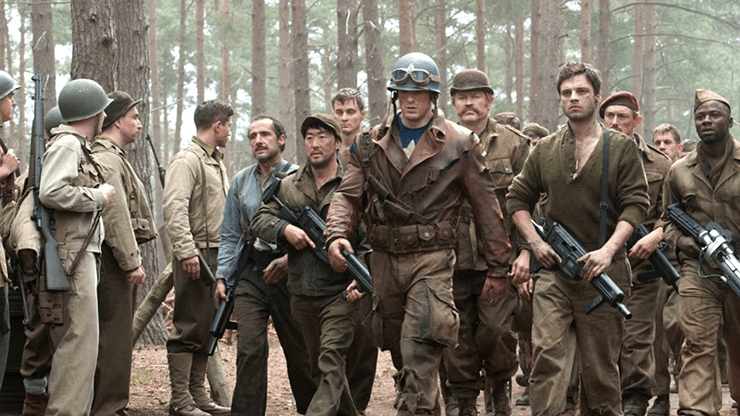
Upon seeing that Rogers and the freed soldiers are making short work of his people, Schmidt sets up the base’s self-destruct. Before he and Zola flee, they confront Rogers and Barnes (who was being experimented upon by Zola). Rogers discovers that Schmidt’s face is a mask covering a skull-like face and red skin, a side effect of Erskine’s earlier version of the formula.
Rogers and the various soldiers trudge back to camp. Phillips—who has already read Carter the riot act—is impressed despite himself. Rogers is given a medal, though he ducks out on the award ceremony (which is attended by a general who looks just like Stan Lee).
While freeing Barnes, Rogers saw a map that shows all of Hydra’s bases. Phillips agrees to let Rogers and a hand-picked team go after those bases. That team includes Dugan, Barnes, and many of the other soldiers he freed. Carter also flirts a bit with Rogers, who isn’t used to it. (He later is ambush-smooched by a female private, the sight of which doesn’t please Carter all that much.)
Stark provides Rogers with a better shield than the one he was using on stage, this made of vibranium, and a more practical version of his star-spangled outfit. Over the next several months, Rogers and his commando team make mincemeat out of Hydra. They go after a train that Zola is riding on, and manage to capture the scientist, though at the cost of Barnes’s life.
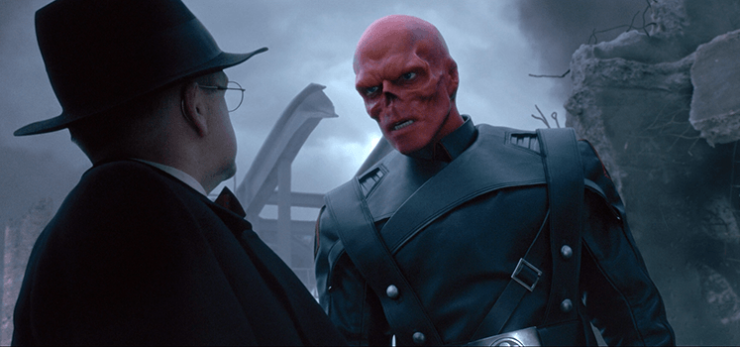
Phillips questions Zola, who is the first Hydra agent they’ve captured who didn’t swallow a cyanide pill. Zola explains that Schmidt has tremendous power at his disposal and he will display it first by wiping out several major U.S. cities. Zola reveals the location of the main Hydra base (which wasn’t on the map Rogers saw) from which he will launch his carrier.
Rogers goes in on a motorcycle with a frontal assault, letting himself get captured, which distracts Hydra long enough for the commandos to attack, backed up by Phillips, Carter, and a ton of soldiers. Schmidt takes off in the carrier, but Rogers is able to leap aboard the landing gear with help from Phillips and Carter (the latter gives him a kiss before he does so). He takes out the Hydra agents who were to fly the smaller craft to the cities to destroy them, and then gets into it with Schmidt. Rogers tosses Schmidt into the containment unit for the Tesseract, which shatters it, letting the object free. Schmidt makes the mistake of picking it up, and it displays a spacescape on the vessel’s roof and seemingly disintegrates him. (We’ll find out in Infinity War that it instead transported him to the planet Vormir.) Rogers can’t let the plane crash land in New York City, so he has to put it down in the Arctic where no one will get hurt. He stays in radio contact with Carter to the end, with them agreeing to go dancing the following Saturday.
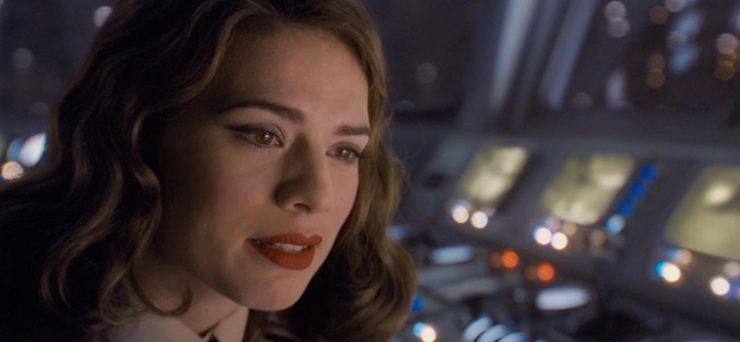
Stark spends the next several years searching for Rogers, but finds only the Tesseract. (Which explains why S.H.I.E.L.D. had it in the post-credits sequence of Thor, and also what Stark and Ivan Vanko used as the basis of their ARC reactor design, as seen in Iron Man and Iron Man 2.) When the war ends, everyone celebrates, except for Carter, Dugan, and the commandos, who drink a toast to “the captain.”
In 2011, Rogers awakens to find himself in a hospital room, a baseball game on the radio. But it’s a game from 1941 that Rogers attended, so he knows the room is a fake. (For that matter, the alleged 1940s nurse has entirely the wrong hairstyle.) He breaks out and runs into the street, only to find himself surrounded by technology he’s never seen before. He’s confronted by Nick Fury, who tells him that he’s been asleep for seven decades. Rogers wistfully says that he had a date…
In the post-credits scene, Fury tells Rogers that he has a mission for him, and then we get a bunch of scenes from Avengers.
“He’s still skinny”
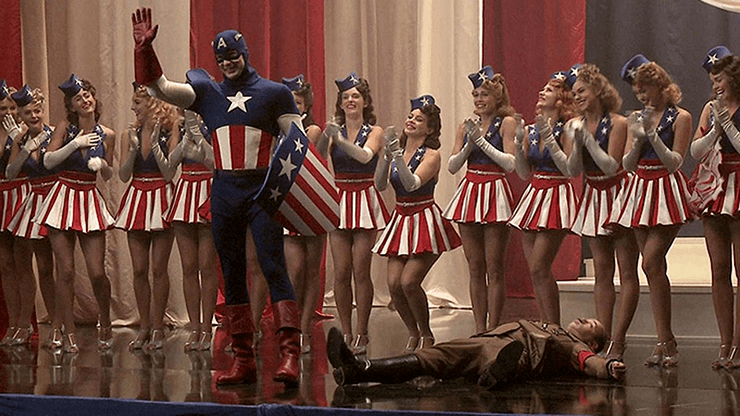
Aside from the whole Brooklyn thing, there is nothing about this movie that I don’t simply adore.
First of all, the script entirely gets Steve Rogers. All we knew about him when we first met him in 1940 was that he was 4F, a sickly young man who still wanted to serve his country. Over the years various folks (Stan Lee and Jack Kirby in the 1960s, Roger Stern and John Byrne in the 1980s, Fabian Nicieza and Kevin Maguire in the 1990s) added more and more to his backstory, establishing the crippling poverty he grew up in, but also that his parents (Irish immigrants) instilled a sense of patriotism and belief in the American dream in him.
The First Avenger doesn’t really deal with the poverty, instead focusing on Rogers’s physical infirmities and determination to stand up to bullies, whether it’s the jerk who won’t stop talking over the newsreels in the movie theatre or Adolf Hitler and Johann Schmidt. Evans absolutely sells this aspect of Rogers’s personality, which is especially impressive since he did the whole thing while green-screening and being computer manipulated into a tiny person and generally probably completely unable to interact properly with the other people on the screen with him. Yet the F/X never get in the way of the characterization, and Rogers comes across as completely honest and true.
And that’s only the beginning of the work Evans does, as he never loses sight of Captain America’s optimism, his intelligence, his compassion, his willingness to stand up for what’s right. In the wrong hands, Cap can be corny, he can be bland, he can be incompetent, he can be naïve, but when done right, he’s a human symbol, and both those words are important. In this movie (and subsequent ones), he’s very much done right, a credit to both the writing and the truly amazing acting that Evans does. He’s inspirational without being hackneyed, noble without being goofy, compassionate without being weak.
Evans is surrounded by a superlative cast, who all support Cap, but provide excellent characterizations beyond that. Stanley Tucci’s Erskine is a delight, full of so many nice touches—responding to Rogers’s query asking where his German-accented self is from with “Queens,” ruefully saying there’s less Schnapps left than there should be the morning of the test, and so on—but also a subdued passion that matches that of Rogers. Tommy Lee Jones is his usual amazing self, bringing an acid cynicism and snottiness that contrasts nicely with Rogers’s earnestness. (He also gets many of the film’s best lines, delivered with Jones’s expected perfection.) Hugo Weaving, for the second time in this rewatch, has portrayed an iconic comics character with far better talent than I’ve seen him evince in other genre roles (he was one of many reasons why I hated The Matrix, and his Elrond was dreadful). His Schmidt has a calm intelligence and a ruthless practicality that makes him incredibly scary. Sebastian Stan’s Barnes is a solid friend and comrade, his easy camaraderie with Evans’s Rogers showing a deep abiding friendship, a bond that will continue through several more movies. Dominic Cooper’s Stark is his son’s father, as the hints of the elder Stark’s seamier side that we saw in the “gag reel” Tony Stark watched in Iron Man 2 are in full force in the younger version. (Hilariously, Cooper’s Howard Stark is much closer to the 1960s version of Tony Stark than Robert Downey Jr.’s Tony was in his two movies.) Neal McDonough’s Dugan is perfect, and I deeply regret that we didn’t get a TV miniseries or a movie or something that was just Dugan, Carter, and the howling commandos continuing to fight the good fight in WWII after Cap stopped Hydra. (As it happens, my favorite episode of the great, underappreciated Agent Carter series is the one McDonough guest stars in as Dugan.) The rest of the Howling Commandos don’t get much to do, but create interesting characters in a very short amount of screen time. (My favorite is Kenneth Choi’s Jim Morita, who whips out his dogtags with practiced frustration when Dugan questions his being freed with the others with a cranky, “I’m from Fresno, ace.”)
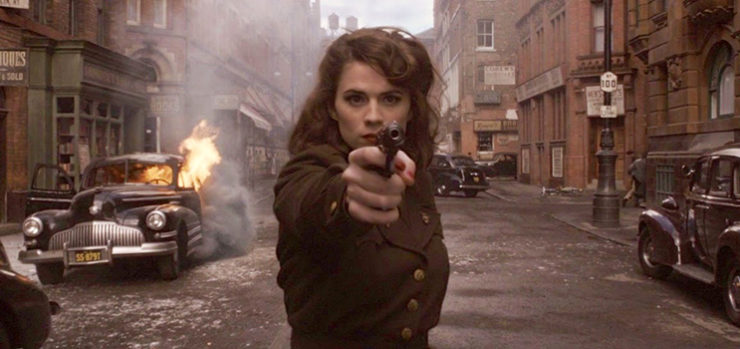
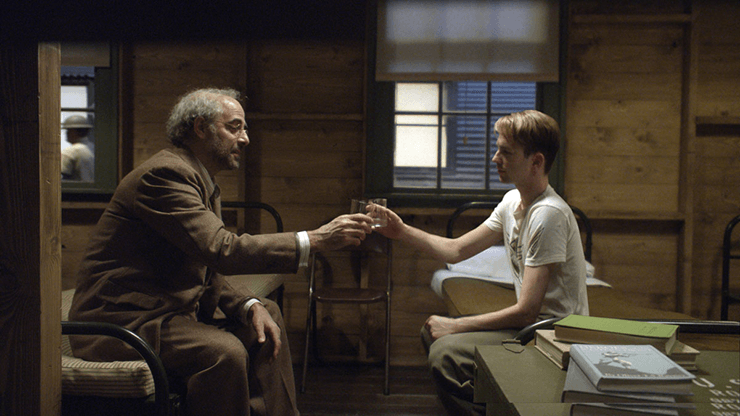
And then we have what may be the single greatest character in the entire Marvel Cinematic Universe, Hayley Atwell’s superlative Agent Peggy Carter. A role that could easily have just been the generic female lead is instead a strong, worthy character. As a woman struggling to succeed in a male-dominated field, she understands Rogers’s struggles trying to fight the good fight while being restricted, though in his case the restriction is physical rather than sociological. In particular, I like the fact that Carter very obviously starts to fall for Rogers before the experiment—what impresses her is the intelligence, the fortitude, the willingness to do whatever is necessary to do what’s right. And when all hell breaks loose after the experiment, Carter is the one who reacts the fastest, even taking out one of the saboteurs with a perfectly placed head shot. And in the end, she’s right there with Phillips and the rest storming Hydra’s base. Atwell will continue to shine, showing up in a one-shot, briefly in the next Cap movie and in Ant-Man, on an episode of Agents of S.H.I.E.L.D., and her funeral is a pivotal scene in Civil War, but it’s on her own tragically short-lived TV show that she has truly proven herself as the rock star of the MCU, and it’s a pity that it didn’t get the ratings it deserved.
The greatest performances in the world will only go so far if the script sucks, but luckily that’s not a problem. This is a prototypical war story, hitting all the beats, but doing so with characters we care about. In fact, the biggest problem with this movie is that, for all that it so completely embraces the trappings of the era (the technology—even that powered by the Tesseract—is still very much mid-20th-century tech, the hairstyles and fashions are completely of the era, the streets of Brooklyn are less refined as befits the time, and Cap’s USO show is 1940s perfection, with “The Star-Spangled Man” a magnificent riff on the music of the period), it isn’t really a World War II movie. I mean, it kind of is, particularly in the early going, but as it progresses, it becomes the SSR (which we’ll later learn is the forerunner to S.H.I.E.L.D.) against Hydra, with the greater war barely acknowledged. Hell, but for the existence of Choi’s Morita, there’s no evidence of a Pacific theatre at all. And I find it impossible to credit that Schmidt was able to continue to function with impunity after disintegrating three of Hitler’s people, an action that is unconvincingly consequence-free for him. Both the Red Skull and Hydra have always been portrayed as an integral part of the Nazi infrastructure, and to have them separate like this is a bit odd. I also think the two-armed salute is a little ridiculous. I can see the story meeting now: “It’s just like the Nazi salute only with both arms so it’s twice as evil!!!!”
Still and all, just as Thor provided an MCU movie that showed it could move beyond the confines of scientists experimenting with things and into more fantastical realms (and also manage without Tony Stark), Captain America: The First Avenger gives the MCU some of the history of superheroing that Nick Fury hinted at in the Iron Man post-credits scene, some of it directly related to what we’ve already seen (the Tesseract, the SSR becoming S.H.I.E.L.D., the background of the experiments on Bruce Banner and Emil Blonsky that tried to re-create Erskine’s formula, etc.). And even without all that texture, it’s a ripping yarn, a rollicking good adventure with great action scenes, superlative characterization, and all of it revolving around a magnificent performance by the lead.
Next week, it all comes together, as we bring Iron Man, the Hulk, Thor, Captain America, and S.H.I.E.L.D. together to face Loki (among others) in Avengers.
Keith R.A. DeCandido knows he’s irrational about the whole Brooklyn thing, but the last straw was when they put up a damn statue. That statue should be on the Lower East Side, dammit.










